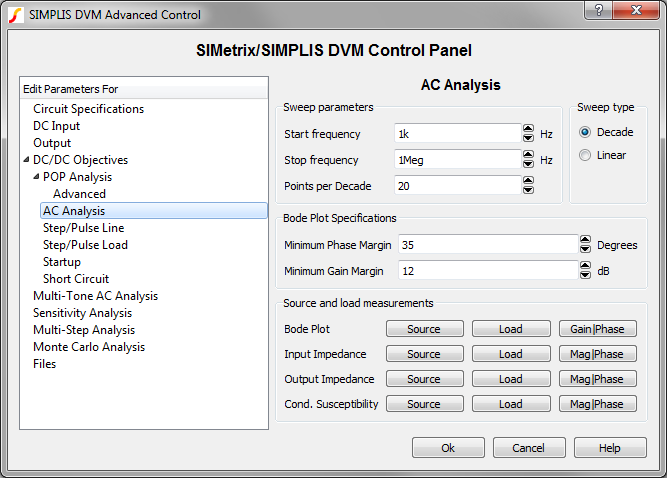Impedance() Test Objective
The purpose of the Impedance() test objective is to measure either the input or output impedance depending on whether the reference designator is a DVM source or load.
- If the reference designator is a source, the input is configured as a DC Input Impedance Source and the output is configured as a Resistive Load.
- If reference designator is a load, the input is configured as a DC Input Source and the output is configured as an Impedance Load.
Since the test objective does not specify the input voltage nor the output current, you must provide these values in the Source and Load columns in the testplan.
Both a POP and an AC analysis are used in the Impedance() test.
- The POP simulation finds the large-signal steady-state operating point of the converter at the specified input and output values.
- The AC simulation perturbs the circuit in a small-signal manner
around the large-signal steady-state operating point.
- If the reference designator is a source, the simulation measures the minimum and maximum input impedance magnitudes and the frequencies where these occur.
- If the reference designator is a load, the simulation measures the minimum and maximum output impedance magnitudes and frequencies from the load looking back to the power supply output.
The POP and AC analysis directives are taken from the POP Analysis page and the AC Analysis page of the Full Power Assist DVM control symbol. The AC Analysis page is shown below.

The test report includes gain, phase, frequency, source, and load graphs as well as the following scalar values which are defined in the Measured Scalar Values section below:
|
|
In this topic:
Testplan Syntax
The Impedance() function has the following syntax with the argument described in the table below:
Impedance(REF) Impedance(REF, OPTIONAL_PARAMETER_STRING)
| Argument | Range | Description |
| REF | n/a | The actual reference designator of the DVM source or load or the generic syntax of INPUT:n or OUTPUT:n where n is an integer indicating a position in the list of DVM sources or loads. |
| OPTIONAL_PARAMETER_STRING | n/a | Parameter string with a combination of one or more parameters: |
parameter_name1=parameter_value1 parameter_name2=parameter_value2The order of the parameter key-value pairs does not matter.
Source and Load Subcircuit Configuration
The Impedance() test objective sets the source and load subcircuits to the following:
| Source | Load |
| DC Impedance Source | Resistive Load |
| DC Input Source | Impedance Load |
Loads other than the output under test are set to the Resistive Load. All other sources are set to the DC Input Source.
Measured Scalar Values
The Impedance() test objective measures the following scalar values,where {load_name} and {src_name} are replaced by the actual load name source name:
| Scalar Name | Description | ||||||||||
| Efficiency | The overall efficiency of the converter taken from the POP simulation | ||||||||||
| Power(LOAD{load_name) | The power of each input source taken from the POP simulation | ||||||||||
| Power(SRC{load_name}) | The power of each output load taken from the POP simulation | ||||||||||
| min_src1_gain | The minimum value for the gain during the AC analysis. | ||||||||||
| max_src1_gain | The maximum value for the gain during the AC analysis. | ||||||||||
| min_src1_gain_freq | The frequency where the gain is at its minimum value | ||||||||||
| max_src1_gain_freq | The frequency where the gain is at its maximum value | ||||||||||
| sw_freq | A number which represents the converter switching frequency. This scalar is generated from a fixed probe with curve label DVM Frequency. For more information, see Measuring the Switching Frequency. | ||||||||||
|
The Average, Minimum, Maximum, RMS and Peak-to-Peak values for each load voltage and current taken over the entire simulation time window. | ||||||||||
|
The Average, Minimum, Maximum, RMS and Peak-to-Peak values for each source voltage and current taken over the entire simulation time window. |
Measured Specification Values
In the following table, {load_name} is the name assigned to each load. The default value is LOAD. DVM forces each load name to be unique so that the scalar and specification values for each load are unique.
| Specification Name | PASS/FAIL Criteria |
| Min_V{load_name} | The minimum value of the output voltage during the simulation time is greater that the minimum specification value. |
| Max_V{load_name} | The maximum value of the output during the simulation time is less than the maximum specification value. |
Testplan Example
The Impedance() test objective is used in several built-in testplans. Shown below are an input and an output test from the DC/DC 1 input/1 output testplan. The managed source and load designators INPUT:1 and OUTPUT:1 are defined in the Full Power Assist DVM control symbol. The tests configures the source to use the Nominal symbolic value from the DC Input page and configures the load based on the Light symbolic value from the Output page. The first test is an input impedance test and the second test is an output impedance test.
| *?@ Analysis | Objective | Source | Load | Label |
| Ac | Impedance(INPUT:1) | SOURCE(INPUT:1, Nominal) | LOAD(OUTPUT:1, Light) | Ac Analysis|Input Impedance|Vin Nominal|Light Load |
| Ac | Impedance(OUTPUT:1) | SOURCE(INPUT:1, Nominal) | LOAD(OUTPUT:1, Light) | Ac Analysis|Output Impedance|Vin Nominal|Light Load |
Optional Parameter String
The following Impedance() test objective uses the OPTIONAL_PARAMETER_STRING argument to instruct DVM to not to set the analysis directive when processing the Impedance() objective entry. You can set an analysis directive with an Analysis entry. The analysis entry should specify a POP and AC analysis. The OVERWRITE_ANALYSIS parameter allows you to explicitly specify the analysis directives.
Impedance(OUTPUT:1, OVERWRITE_ANALYSIS=0)
Test Report
You can view the complete test report in a new browser window here: Output Impedance Test Report. Below is an interactive link to the same test report.